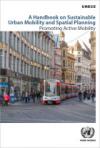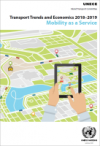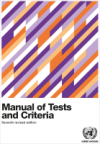Publications
Displaying Results 21 - 40 of 158
- English
Member States in the ECE and WHO European Region established the Transport,Health and Environment Pan European Programme (THE PEP) in 2002. By providing an intersectoral and intergovernmental policy framework, THE PEP promotes mobility and transport strategies that integrate environmental and health concerns. Over the years, THE PEP has led to the development of implementation mechanisms to
- English
Mobility as a Service (MaaS) is a new mobility concept gaining pace in many cities around the world. Its value proposition concerns integration of mobility services which is realized by providing trip planning and one-stop fare purchase for the user through a single platform.Since MaaS is only emerging, the analysis of real-life demonstrations is still limited and, thus, evidence on the
- English
Regional maps available here
Extreme weather events, some of which are increasing in intensity and frequency, as well as slower onset climate changes (for example, sea level rise) and cumulative effects can result in transportation infrastructure damages, operational disruptions, and
- English
ST/SG/AC.10/11/Rev.7
Sales No. E.20.VIII.1
ISBN 978-92-1-130394-0
eISBN 978-92-1-004503-2
Languages: E, F, (A, C, R, S forthcoming)
How to order this publication?
This publication is also available online for free (download).
The "Manual of Tests and Criteria" contains criteria, test methods and
- English
These recommendations have been developed in the light of technical progress, the advent of new substances and materials, the exigencies of modern transport systems and, above all, the requirement to ensure the safety of people, property and the environment. They are addressed to governments and international organisations concerned with the regulation of the transport of dangerous goods. The
- English
The GHS addresses classification of chemicals by types of hazard and proposes harmonized hazard communication elements, including labels and safety data sheets. It aims at ensuring that information on physical hazards and toxicity from chemicals be available in order to enhance the protection of human health and the environment during the handling, transport and use of these chemicals.
The GHS
- English
The European Agreement concerning the International Carriage of Dangerous Goods by Inland Waterways (ADN) done at Geneva on 26 May 2000 under the auspices of the United Nations Economic Commission for Europe (UNECE) and the Central Commission for Navigation on the Rhine (CCNR) has been in force since February 2008. The Agreement currently has eighteen Contracting Parties. The Regulations
- English
Adopted on 30 September 1957 in Geneva under the auspices of the United Nations Economic Commission for Europe (UNECE), the ADR entered into force on 29 January 1968. This authoritative Agreement is intended to increase the safety of international transport of dangerous goods by road. Its Annexes A and B contain the technical requirements for road transport, i.e. the conditions under
- English
During recent decades governments all around the world were faced with a complicated set of options for investing in transport, including transport infrastructure. This publication examines main principles for determining the most appropriate models for financing transport infrastructure expenditures but also illustrates and analyses many innovative ways to finance transport infrastructure.
- English
The GHS addresses classification of chemicals by types of hazard and proposes harmonized hazard communication elements, including labels and safety data sheets. It aims at ensuring that information on physical hazards and toxicity from chemicals be available in order to enhance the protection of human health and the environment during the handling, transport and use of these chemicals.The GHS
- English
These recommendations have been developed in the light of technical progress, the advent of new substances and materials, the exigencies of modern transport systems and, above all, the requirement to ensure the safety of people, property and the environment. They are addressed to governments and international organisations concerned with the regulation of the transport of dangerous goods. The
- English
The European Agreement concerning the International Carriage of Dangerous Goods by Inland Waterways (ADN) done at Geneva on 26 May 2000 under the auspices of the United Nations Economic Commission for Europe (UNECE) and the Central Commission for Navigation on the Rhine (CCNR) has been in force since February 2008. The Agreement currently has eighteen Contracting Parties.The Regulations
- English
Adopted on 30 September 1957 in Geneva under the auspices of the United Nations Economic Commission for Europe (UNECE), the ADR entered into force on 29 January 1968.This authoritative Agreement is intended to increase the safety of international transport of dangerous goods by road. Its Annexes A and B contain the technical requirements for road transport, i.e. the conditions under which
The United Nations Transport Conventions on border crossing facilitations – Benefits for governments
- English
This leaflet, prepared by the Sustainable Transport Division of the UNECE in cooperation with the International Road Transport Union (IRU), highlights the importance and potential benefits to Contracting Parties of the Customs Convention on the International Transport of Goods under Cover of TIR Carnets and the International Convention on the Harmonization of Frontier Controls of Goods.It
- English
ST/SG/AC.10/11/Rev.6Sales No. E.15.VIII.3ISBN 978-92-1-139155-8Price: US$ 125Languages: E, F, S (A, C, R forthcoming)How to order this publication?This publication is also available online for free (download).The Manual of Tests and Criteria contains criteria, test methods and procedures to be used for classification of
- English
The inclusion of urban transport in the SDG 11 is further confirmation that transport is an essential component of the overall sustainable development. It is crucial to eradicating poverty and economic growth (access to markets and jobs), improving education (access to schools), protecting child and maternal health (access to medical services), and enhancing
- English
- English
The GHS addresses classification of chemicals by types of hazard and proposes harmonized hazard communication elements, including labels and safety data sheets. It aims at ensuring that information on physical hazards and toxicity from chemicals be available in order to enhance the protection of human health and the environment during the handling, transport and use of these chemicals.The GHS
- English
These recommendations have been developed in the light of technical progress, the advent of new substances and materials, the exigencies of modern transport systems and, above all, the requirement to ensure the safety of people, property and the environment. They are addressed to governments and international organisations concerned with the regulation of the transport of dangerous goods. The
- English
The European Agreement concerning the International Carriage of Dangerous Goods by Inland Waterways (ADN) done at Geneva on 26 May 2000 under the auspices of the United Nations Economic Commission for Europe (UNECE) and the Central Commission for Navigation on the Rhine (CCNR) has been in force since February 2008. The Agreement currently has eighteen Contracting Parties.The Regulations



















